
Evaluation of long-term investments in black walnut plantations. depends on tree growth rates, log quality, and costs incurred, as well as the expected price for logs when the trees are big enough to sell. This publication reviews price changes over the last 40 years and discusses two basic ways to predict future prices using historical price trends. Particular attention is paid to the folly of predicting prices based on a portion of a cycle in prices and of using compound rates of increase to project prices with the effects of inflation removed.
Walnut price data collected for Indiana show that the dramatic price increases of the 1970's and early 80's have yielded to a period of decline followed by renewed increases at a much lower rate. The sawmills and veneer mills processing black walnut apparently realized that the dramatic higher prices paid in the 1970's and early 1980's couldn't be passed on to buyers of lumber and veneer. In addition, the supply of black walnut timber was so scarce that higher prices could do little to make more timber available for harvest.
Based on these observations, it's suggested that the most appropriate way to predict future walnut prices is to use a long-term average trend- line price. The approach is recommended for estimating the financial returns from investments in plantations, not for timber marketing decisions. Marketing decisions should take into account current market conditions. Most owners of timber have the option of waiting out a decline in price levels.
The market for walnut logs in Indiana is highly developed and based on over a century of fine hardwood processing. Logs are shipped to Indiana mills from many other states. Thus, the Indiana price data reflect regional market conditions. However, the amount actually paid to landowners for stumpage varies greatly across the region. Thus. you should seek information from consulting foresters and others familiar with your local market conditions to determine the relationship between the reported prices and prices in your area.
These changes were apparently due to log supply conditions and not increased demand for lumber. Walnut lumber prices change very little (Table 2). The amount of change in a specific size and grade of log is also due in part to sampling error.
Veneer log prices generally declined from the spring of 1993 to 1994 (Table 3). The only exception was for larger lower grade (select) logs. Improvements in processing technology, especially veneer drying, have increased the value of these logs. The upper grade logs (prime) were down from 4 to 16 percent. The larger select logs were up 17 percent to over 50 percent. Smaller select logs were down 6 to 9 percent.
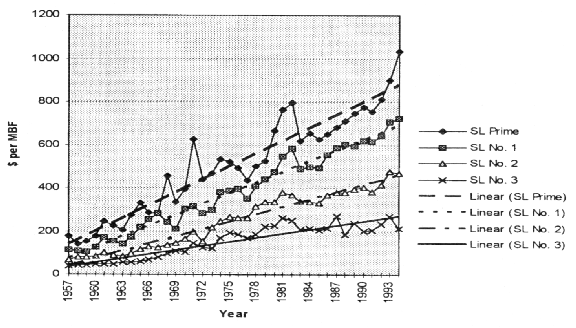
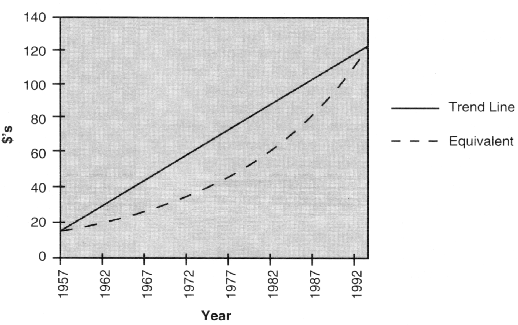
No. Respon. Mean (s.e)1 Median Change (%)
Grade Range 1993 1994 1993 1994 1993 1994 Mean Median
----------------------------------------------------------------------------------
Prime 150-2500 30 20 900 1035 900 1000 15.0 11.1
(40.4) (103.4)
No. 1 100-1000 33 24 708 725 700 725 2.4 3.6
(28.9) (37.7)
No. 2 200-800 32 25 478 470 500 500 -1.7 0.0
(24.7) (33.0)
No. 3 150-350 28 15 270 215 250 200 -20.4 -20.0
(18.2) (14.1)
1 Standard error of the mean is given in parentheses below the mean.
Lumber Jul'91 Jan'92 Jul'92 Jan'93 Jul'93 Jan'94 Jul'94
Grade
---------------------------------------------------------------------------------
Black Walnut
FAS 1605 1605 1605 1605 1605 1615 1615
No. 1C 855 855 855 855 855 855 855
No. 2A 290 290 290 290 290 290 290
No. Respon. Mean (s.e.)1 Median Change (%)
Species/Grade/ '94
Leg Dia. Range '93 '94 '93 '94 '93 '94 Mean Median
---------------------------------------------------------------------------------------
Prime ($/MBF) ($/MBF)
---------------------------------------------------------------------------------------
12-13 1000-2500 6 7 1850 1786 1750 2000 -3.5 14.3
(269.3) (184.4)
14-15 2000-3000 7 8 2543 2438 2500 2250 -4.1 -10.0
(385.4) (175.2)
16-17 2500-5000 6 8 3742 3500 3875 3000 -6.5 -22.9
(552.3) (313.4)
18-20 3000-6000 6 6 4625 4500 4375 4250 -2.7 -2.9
(768.5) (447.2)
21-23 4000-5500 4 3 5375 4833 5000 5000 -10.1 0.0
(1028.2) (441.0)
24-28 4000-8000 2 3 7000 5833 7000 5500 -16.7 -21.4
(1000.0) (1166.7)
>28 4000-10000 1 3 6000 6500 6000 5500 8.3 -8.3
(1802.8)
Select
12-13 800-1500 4 5 1425 1300 1500 1500 -8.8 0.0
(75.0) (137.8)
14-15 1000-2000 6 6 1767 1667 1750 1750 -5.7 0.0
(197.8) (166.7)
16-17 1500-4000 5 6 2060 2417 1700 2000 17.3 17.7
(294.3) (374.5)
18-20 3000-6000 5 4 2480 3750 2000 3000 51.2 50.0
(453.2) (750.0)
21-23 4000 4 1 3050 4000 3100 4000 31.2 29.0
(550.0)
24-28 7000 1 1 4000 7000 4000 7000 75.0 75.0
>28 8000 0 1 --- 8000 -- 8000 -- --
---------------------------------------------------------------------------------------
1 Standard error of the mean is given in parentheses below the mean
The price increases observed for walnut in the late 1970's and early 1980's with the affect of inflation removed, i.e. real prices, couldn't continue. To illustrate, consider the relative value of a board foot of walnut and a new car 40 years from now. Say the walnut is veneer quality timber now worth $5.00 a foot and the car is worth $20,000. both in terms of what a dollar will buy in 1994. The car is equivalent in value to 4,000 board feet (MBF) of walnut veneer logs. Now assume that walnut prices increase 8 percent per year in terms of 1994 dollars for 40 years and the price of the car stays the same. The walnut price goes to $109 per board foot. The car is then equivalent in value to 184 board feet of walnut. In general, however the relative values for the mix of goods and services consumers desire don't change that dramatically. By the way, car prices have increased primarily because of inflation and additional features, not because the real cost of basic labor and material inputs have increased.
Let's next consider walnut price trends and discuss whether or not they are sustainable at current levels.
Veneer Leg Grade
Leg Size Prime Select
------------------------------------------
12-13 2.246 1.522
14-15 3.910 1.169
16-17 1.833 1.783
18-20 2.039 2.283
21-24 2.268 1.975
25-28 2.023 1.871
>28 2.246 2.379
Sawlogs Prime Veneer Logs Select Sawlogs
Grade Slope Intercept Size Slope Intercept Size Slope Intercept
(in.) (in.)
--------------------------------------------------------------------------------------
SLPrime -1.64872 800.3871 16-17 41.21946 1493.375 16-17 25.73094 969.1857
SL No.1 1.37384 532.6862 18-20 56.16011 1745.933 18-20 38.42414 1008.315
SL No.2 2.28446 312.1157 21-24 70.14297 1860.165 21-24 40.19652 1308.754
SL No.3 0.977718 203.7385 24-28 74.64466 2344.795 24-28 44.79385 1575.474
>28 86.23988 2319.89 >28 60.54943 1491.143
12-13 23.36613 1177.36 12-13 15.21029 826.2637
14-15 23.36424 1666.254 14-15 51.81863 881.0242
--------------------------------------------------------------------------------------
Investments should be judged in terms of the actual increase in purchasing power of the money invested. Therefore, we need to look at the price increase in terms of constant (real) dollars. The producer price index for finished goods is used as the indicator of inflation (Figure 3). Consumer prices follow the same pattern as producer prices over the long run. The trend line for inflation is equivalent to a 6.3 percent compound interest rate. To protect the purchasing power of the amount invested. the timber should increase in unit price at least at this rate. It's the total real rate of return, however, that should ultimately be used to decide on whether or not to make the investment.
The degree to which the increase in price has kept up with inflation is judged by "deflating" log prices. This is done by dividing the actual price by the producer price index. The resulting "real price" series can be used to evaluate the real price increase.
The real price of prime sawlogs increased dramatically, although in cycles, from 1957 to 1971 (Figure 4). After 1971 the real prices for prime sawlogs have not kept up with inflation. The trend line reflects a 0.2 percent decline. The real price of the lower grade logs has just barely kept up with inflation. The real increases for the 1957 to 1994 period were 0.2. 0.6, and 0.4 percent for No. 1, No. 2. and No. 3 sawlogs respectively.
Year Prime No.1 No.2 No.3 PP ---------------------------------------------- 1957 176 114 67 41 32.5 1958 142 108 80 45 33.2 1959 155 106 82 45 33.1 1960 176 127 86 49 33.4 1961 245 170 99 50 33.4 1962 225 155 87 50 33.5 1963 205 142 85 58 33.4 1964 273 175 95 58 33.5 1965 333 218 116 60 34.1 1966 288 254 128 68 35.2 1967 284 283 126 80 35.6 1968 457 243 138 98 36.6 1969 335 212 145 109 38.0 1970 394 303 165 107 39.3 1971 627 314 199 147 40.5 1972 440 282 153 124 41.8 1973 467 300 217 121 45.6 1974 532 379 248 169 52.6 1975 521 387 265 195 58.2 1976 491 394 262 185 60.8 1977 436 352 263 171 64.7 1978 499 407 315 185 69.8 1979 525 442 335 222 77.6 1980 668 473 334 226 88.0 1981 764 544 381 264 96.1 1982 796 581 368 249 100.0 1983 620 490 339 210 101.6 1984 655 495 336 214 103.7 1985 627 493 333 206 104.7 1986 652 554 369 214 103.2 1987 681 586 381 271 105.4 1988 712 601 379 186 108.0 1989 749 594 397 239 113.6 1990 777 619 406 201 119.2 1991 754 613 383 207 121.7 1992 813 643 416 235 123.2 1993 900 708 478 270 124.7 1994 1035 725 470 215 125.5 ----------------------------------------------
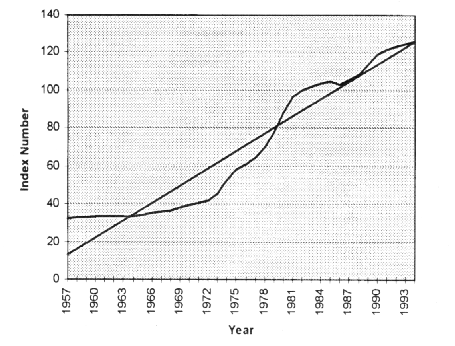
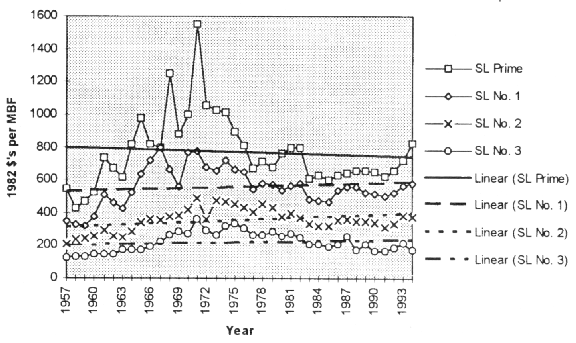
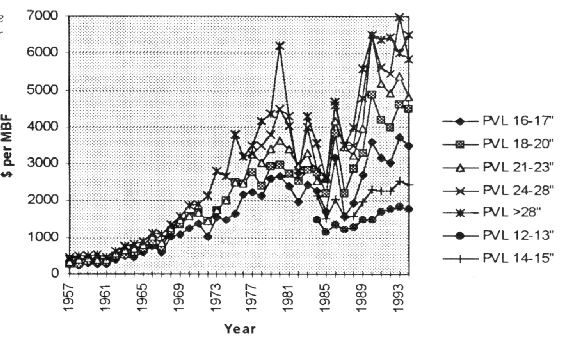
Prime Veneer Logs Select Veneer Logs
Year 12-13" 14-15" 16-17" 18-20" 21-23" 24-28" >28" 12-13" 14-15" 16-17" 18-20" 21-23" 24-28" >28"
----------------------------------------------------------------------------------------------------
1957 261 261 333 400 475 178 178 241 293 334
1958 215 280 398 480 480 165 190 275 360 360
1959 285 350 443 500 500 243 285 323 363 363
1960 280 328 412 540 540 215 260 320 405 405
1961 260 318 410 463 463 213 245 298 353 353
1962 408 500 545 635 635 273 318 373 428 428
1963 495 540 655 760 760 290 370 455 550 550
1964 460 580 700 840 840 298 345 450 575 575
1965 608 697 790 885 885 449 558 600 634 634
1966 755 894 1027 1115 1115 438 492 619 737 737
1967 604 733 858 1077 1077 460 508 560 740 740
1968 1009 1195 1244 1340 1340 734 808 834 910 910
1969 1083 1360 1500 1594 1594 575 758 812 883 883
1970 1250 1578 1578 1875 1875 781 936 936 1170 1170
1971 1381 1687 1687 1907 1907 550 550 818 944 944
1972 1035 1467 1467 2150 2150 929 929 1182 1633 1633
1973 1557 1750 1750 2800 2800 660 660 850 i1021 1021
1974 1498 2005 2005 2659 2659 874 874 1850 2517 2517
1975 1659 2493 2493 3793 3793 1043 1043 1719 2505 2505
1976 2193 2483 2483 3188 3188 1286 11286 1556 1930 1930
1977 2242 2766 3280 3280 3500 1683 2000 2375 2150 2175
1978 2140 2400 3027 3500 4157 1190 1675 2105 2525 3675
1979 2608 2941 3412 3808 4350 1542 1785 2150 2428 2642
1980 2661 2966 3634 4500 6214 2024 2509 3061 3606 4800
1981 2404 2725 3394 4015 4298 1666 1843 2246 2317 2075
1982 1966 2540 2933 2825 2666 1450 2100 2250 2233 2750
1983 2440 2850 3300 4000 4300 1550 2100 1500 1600 2250
1984 1470 2133 2270 2775 2533 2866 3550 1120 925 1475 2087 1650 1800 1950
1985 1150 1533 1708 2228 2614 2666 2625 775 1000 1371 1625 1825 1433 1500
1986 1340 2060 3180 3820 4160 4575 4700 1000 1150 1420 1440 1480 1675 1875
1987 1220 1560 1600 2200 3466 3500 3500 800 1050 1125 1466 1966 1700 2850
1988 1300 1590 1940 2880 3250 3500 4000 800 1163 1325 1925 2267 1500 1800
1989 1482 1993 2695 3305 3965 4792 5594 1030 1496 2088 2764 3343 4383 5750
1990 1480 2300 3600 4875 6500 6500 6500 1025 1500 2100 2600 3000 3000 3000
1991 1728 2281 3177 4182 5188 5625 6375 1200 1757 2143 2750 3333 3800 4200
1992 1780 2293 3054 3996 4907 5443 6429 1075 1617 2050 2286 2600 2600 2625
1993 1850 2543 3742 4625 5375 7000 6000 1425 1767 2060 2480 3050 4000 4000
1994 1786 2438 3500 4500 4833 5833 6500 1300 1667 2417 3750 4000 7000 8000
The deflated (real) prices and trend lines for the seven size classes of prime and select veneer logs are shown in Figures 7 to 10. The long-term trend lines show a pattern similar to sawlogs. The trend lines don't, however, reflect prices during the 1970's and overestimate price levels in the 1957 to late 1960's, and again from the late 1980's to the early 1990's. High prices in the 1970's "pulled up" the trend line, placing it well below the exceptionally high prices of the 1970's. The unsustainably high prices of the 1970's caused projections based on the 1957 to the early 1980's data to yield grossly exaggerated estimates of increases.
Applying the concept of an average compound rate of increase for the trend lines for veneer logs, as discussed for sawlogs, gives higher rates of increase than for sawlogs. The trend line increases for veneer logs are given in Table 4. The largest increases are for small, high-quality veneer logs. This is inconsistent with pricing patterns over the last several years. Comparisons between the two smallest classes and the other size classes must be made with caution. Prices for 12 to 15 inch logs weren't collected until 1984. This was several years after markets for small veneer logs were well established.
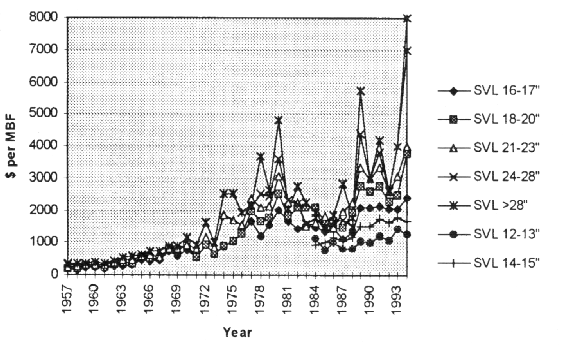
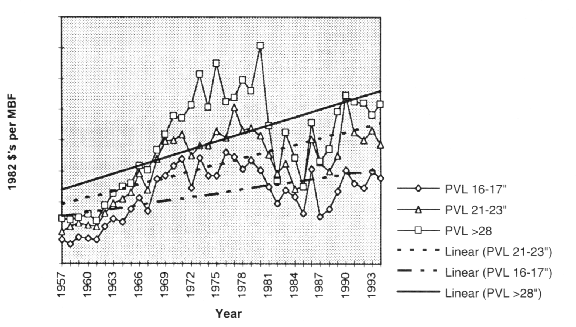
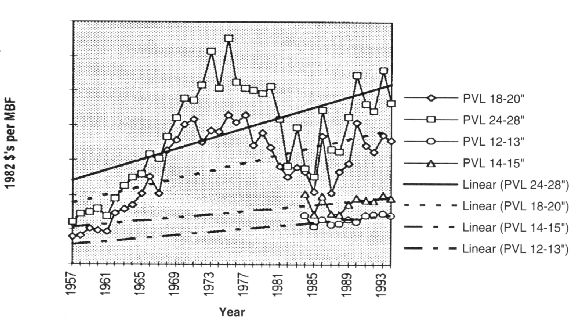
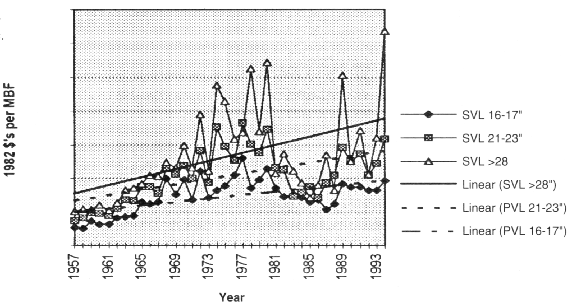
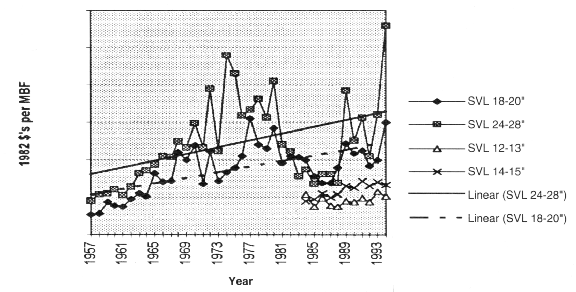
Investors also frequently use current prices to make investment analyses. Since walnut log prices are cyclical, this could give an unreasonably high or low level. An alternative is to use the current price from the trend line. If you believe that prices will continue to increase based on historical patterns, then use the equation for a straight line to project the price. The equation is,
P = a + b T,
where, "a" is the intercept and "b" is the slope. These values are given in Table 5. "T" ranges from 1 to 38 for years 1957 to 1994 for sawlogs and the five largest veneer logs sizes. "T" ranges from 1 to 11 for years 1984 to 1994 for the two smallest veneer log sizes. To project the price of a given type of log, substitute into the equation the value of T for the number of additional years of interest. For example. the 1982 base year trend line price for one thousand board feet (MBF) of 16-17 select veneer logs in the year 2039 (45 year projection), would be,
Price = 969.18 + 25.731 x (83) = $3,105 per MBF
Note that if the exponential method was used the projected price would be,
Price 1947 x (1.01783)^ 4/5 = $4,313 per MBF
In this equation $1,947 is the trend line price in 1994 and 1.01783 is (1 + i), where i is the interest rate from Table 4. The exponent, 45, is the number of years the price is compounded at 1.783 percent per year.